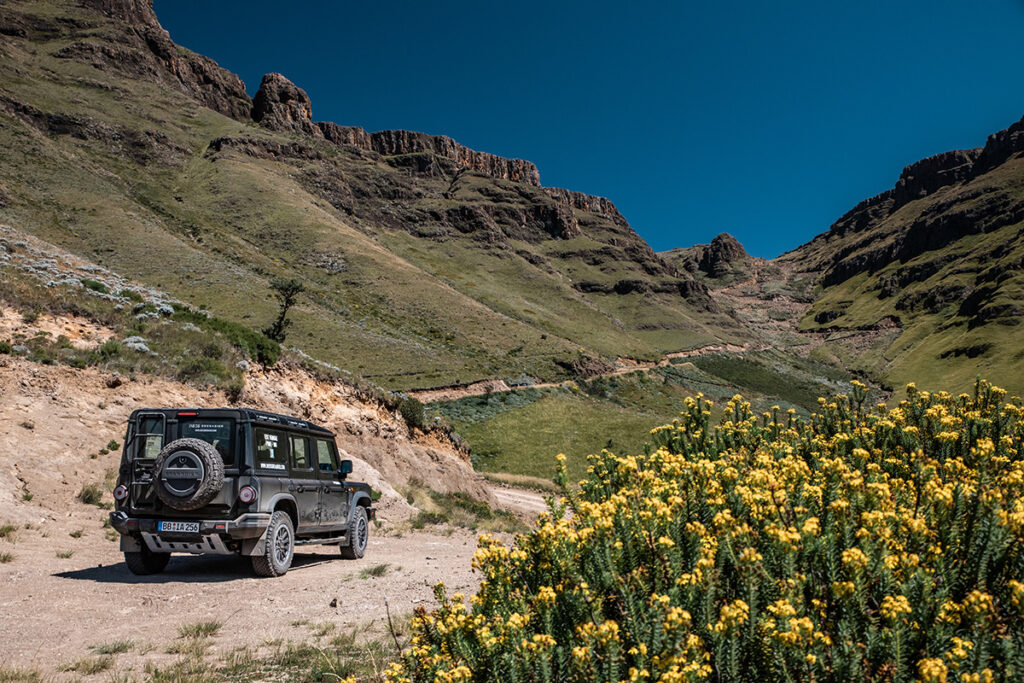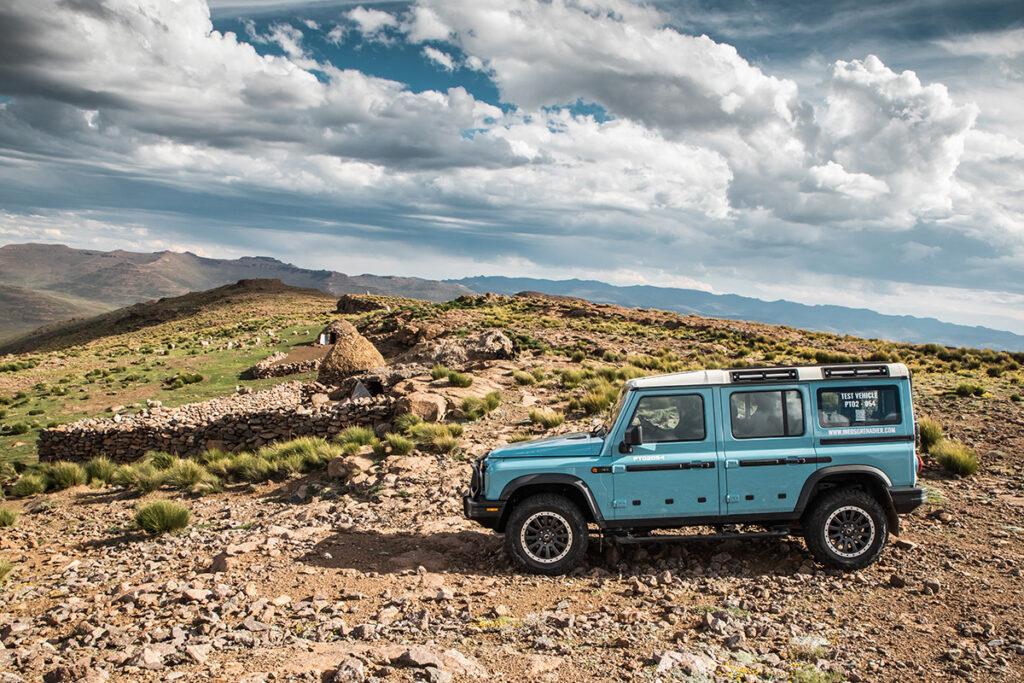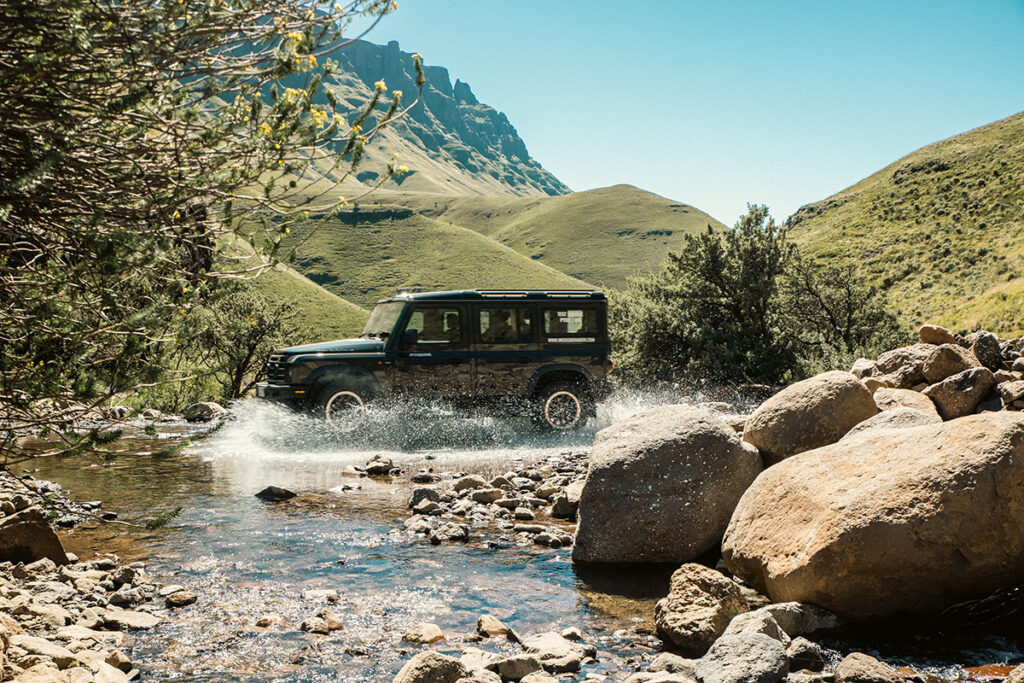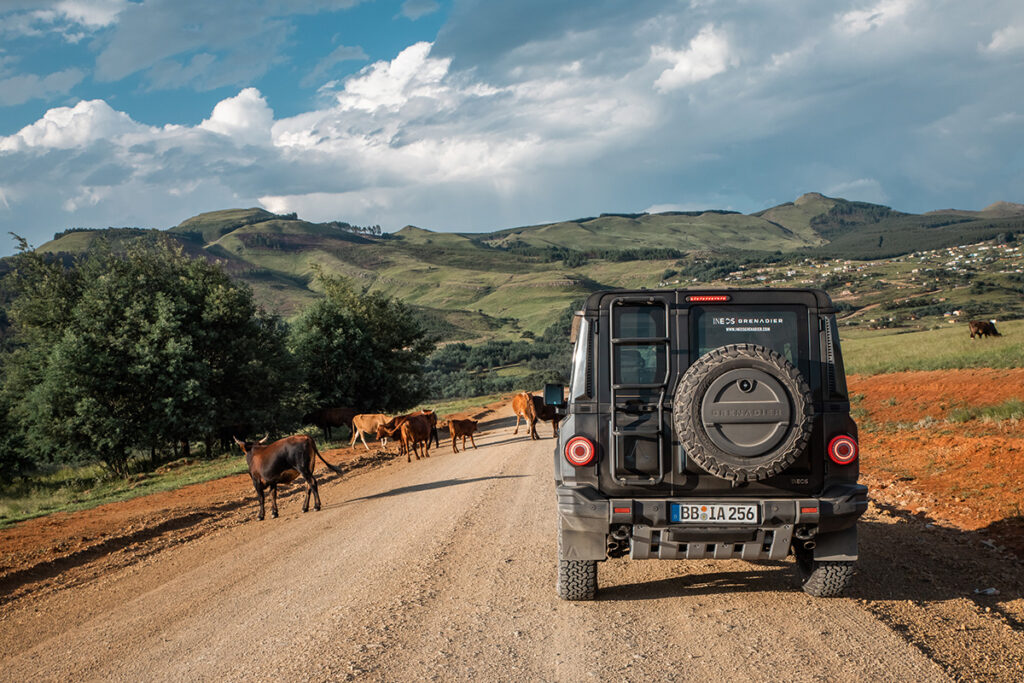From The Grenadier Pub at only 16 m above sea level to the highest pub in Africa – 2 876 metres above sea level – there could be no better place to take final pre-production models of the new INEOS Grenadier than up the steep Sani Pass into Lesotho, coincidentally on Moshoeshoe’s Day …
The small convoy of 4×4s slowly yet effortlessly crawled up the steep mountain pass. Starting at 1 544 metres, the Grenadiers made their way up the twisty gravel road, with a gradient up to 1:3, to an altitude of 2 876 metres. It was a warm, cloudless day and the views over the valley and KwaZulu-Natal hinterland was simply spectacular.
It was also Moshoeshoe Day, a public holiday in Lesotho, observed on 11 March, to commemorate the founding father and first King of Lesotho, Moshoeshoe I. An important day for the Basuto people, as it was Moshoeshoe who kept the Mountain Kingdom separate from South Africa, it is interestingly celebrated on the anniversary of his death in 1870, as while it is agreed he was born in 1786, the exact date of his birth is not known.
After an uneventful ascent (although some of our group members had to assist some fatigued motorcyclists in the final set of tight S-bends) and a quick border crossing, we parked off at the famous highest pub in Africa for a celebratory toast to Sir Jim Ratcliffe, who about six years ago in the Grenadier Pub in Belgravia, London, conceived the idea for a stripped back, utilitarian, hard-working 4×4 vehicle engineered for modern day compliance and reliability.
Actually, the story goes, Sir Jim initially approached Land Rover to acquire the rights to the original Defender after production of this iconic vehicle was stopped in 2016. Land Rover rejected the offer, so he decided to build his own version of the iconic off-roader – named for the pub where the initial idea was formulated.

A Bespoke 4×4
With straightforward, simple design lines reminiscent of the original Defender with Series III and early Beijing Jeep type nose treatment, the Grenadier certainly looks the part. It leaves no ambiguity about its role as a utilitarian, yet comfortable, practical, durable, and reliable workhorse that will meet the expectations of the modern 4×4 driver.
The timeless, boxy form includes practical features such as interchangeable round lamps at the front and rear, standard centre LED auxiliary high beam lights integrated into the front grille, flat front wings ideal for resting kit on, and bump strips for the belt line along the bodysides (an optional utility belt can be added for attaching accessories).
To fettle the Grenadier, INEOS Automotive hand-picked the best suppliers from the automotive industry – Magna Steyr tuned the Eibach sprung suspension, and BMW engines feed power though ZF transmissions. Tremec transfer cases and Eaton diffs to Carraro axles with Dana Spicer CV joints and prop shafts to Bridgestone-shod wheels – before taking all these quality components through an arduous testing regime of 1.8 million kilometres, in all climates, in all conditions, across all terrains.
Considering our initial impressions of the final pre-production versions of the 4×4 newcomer, it seems all have come together rather nicely, thank you. With a sturdy ladder-frame chassis and short overhangs front and rear, the Grenadier has an approach angle of 36.2 ̊, a breakover angle of 28.2 ̊, and departure angle of 36.1 ̊ – more than enough to overcome any serious obstacle.
All this, as well as ground clearance of 264 mm and a wading depth of 800 mm meant the jaunt up Sani Pass was not really a challenge for either the petrol or diesel derivatives (the dedicated Off-Road Mode or integrated Wading Mode proved superfluous), and their smooth power delivery and immaculate ride comfort over the rock-strewn parts of the track was impressive.

Petrol, or Diesel?
The evocative sound of the proven BMW 3.0-litre straight-six B58 turbo petrol engine, delivering 210 kW and 450 Nm of torque (from a low 1 750 rpm to 4 000 rpm), was quite audible thanks to a bespoke exhaust system, and with its torque sweet spot at 2 000 rpm it lugged the 2.6-ton five-seat station wagon up steep inclines with ease.
Sampling the diesel derivative, powered by the revered 3.0-litre twin-turbo six-cylinder mill from BMW, on the high-altitude Lesotho tracks, we started to favour its immediate torque delivery (550 Nm from 1 250 rpm to 3 000 rpm) and smooth power delivery (183 kW) in the mountainous terrain.
To be fair, both models performed impeccably on the route, but the conditions favoured the characteristics of the diesel (the petrol would probably be more suitable in sandy terrain and for driving high dunes). Having driven both, we suspect the choice between diesel and petrol will come down to personal preference …
This also applies to the choice between Trailmaster Edition or Fieldmaster Edition specification (if the normal model, at just over R100k less, is not enough). Inspired by the quality outerwear from Belstaff, the pre-configured editions (with Smooth Pack and Rough Pack trim features) have been specifically curated – the Trailmaster for extreme off-roading and the Fieldmaster for adventure lifestyle …

The Rough, and Smooth
Besides the additional Rough Pack adding front and rear diff locks and BF Goodrich All-Terrain tyres, as well as practical kit, including a raised air intake, exterior utility belts, and an auxiliary battery, the hardcore Trailmaster, somewhat confusing, also receive Smooth Pack features, as available on the Fieldmaster Edition.
The Smooth Pack is a collection of comfort and convenience features, including a rear-view camera, puddle lamps, power heated door mirrors, auxiliary USB power outlets, 17-inch alloy wheels (with 18-inch alloys as option), Safari Windows, leather upholstery, carpet floor mats, and heated front seats.
In the Fieldmaster Editions, we really appreciated the removable, tinted Safari Windows (optionally available on other variants) above the driver and co-driver. Completely removed (it can be stored safely in a dedicated bag), it allowed our photographer to get some great shots of the beautiful surroundings – illustrating how it can be used in practice.

Aircraft-style Front Cabin
Inside, the front cabin has a cockpit-feel to it, with aircraft-style instrumentation (complete with guards to avoid inadvertent operation) in the centre console and a bank of toggle switches (for the off-road switch gear) in the overhead control panel. The buttons are clearly labelled and well-spaced (for use with gloves) and all driving info is conveniently displayed on one screen.
Befitting the image of a tough off-road vehicle, the controls, while mostly digital, has an old-school mechanical look and feel to them. The lack of an instrument binnacle in front of the driver feels odd at first but one gets used to it. However, with all the driving information displayed on a centrally positioned 12.3-inch touchscreen, the attention of the driver can get distracted …
Even so, the Central Control System displays all required information in one place, from speed, gear, and fuel level through to tyre pressures, maps, media, phonebook, current bearing, coordinates, steering angle, vehicle attitude, and more … and it can be accessed using the buttons on the steering wheel or the BMW-style rotary controller on the centre console.
In front of the controller is a genuine BMW gear lever and sturdy-looking gear knob to mechanically engage the two-speed transfer case for the permanent four-wheel-drive system. The touchscreen also displays a clear view of the steering angle, and our Belstaf-edition vehicles also had the Pathfinder navigation system, as well as a rear-view camera and parking sensors.
Besides buttons for sound and cruise control on the two-spoke multifunction steering wheel, a red “toot button” with bicycle symbol (for discreetly warning cyclists and equestrians) is a very British touch … although for South Africa it probably needs a minibus taxi sign and a much louder horn(!).
Standard also is a radio, Android Auto, and wireless Apple CarPlay compatibility, Bluetooth connectivity and voice control, USB-A, USB-C, and 12V sockets. Trim for the spacious, airy cabin is unpretentious, yet refined and we found the eight-way, manually adjustable Recaro seats (with optional leather upholstery in our vehicles) supportive and comfortable in all conditions.
Folding the 60:40 split rear bench seat flat, provides for 2 035 ℓ of load space, and with the rear seats in use, the load space is a class-leading 1 152 ℓ. The Grenadier has best-in-class roof loading capabilities, and built-in roof rails and rubber protection strips are standard.

Road Comfort
For a ladder-frame based vehicle, the Grenadier again surprised with its quiet cabin, body control, agility, and smooth ride on the undulating, pothole-scarred road leading from Himeville and Bergville towards Howick – thanks to the body being isolated from the ladder-frame by eight chassis mounts, reducing body vibrations, and a well-tuned suspension setup.
We did, however, find the steering, while accurate and well-weighted, to be slow to self-centre (requiring driver assistance to get it back to the straight-forward position) and the spare tyre positioned on the back of the 30:70 split rear doors, greatly affected and diminished vision to the rear.
Approaching the Durban airport on the highway near Umhlanga in an unseasonal rainstorm, the numerous in-built safety systems of the Grenadier proved their worth on the wet road when we had to evade an accident happening right in front of us. Luckily, we managed to avert it, and besides some very bent vehicles, it seems no-one was injured in the crash.
Safely at the airport, I again took stock of the new Grenadier and to me it is clear INEOS and Sir Jim did their homework before releasing this newcomer into a highly competitive market segment. As a built-on-purpose 4×4 with serious off-road capability, refined on-road driveability, and a functional, modern, comfortable interior, it ticks the boxes.
As such, and with a wide range of options and accessories available to configure it to your liking, the Grenadier – now locked and loaded – surely will take the fight to the expensive Mercedes-Benz G-Class on the one hand, the Land Cruiser 79 on the other, and anything in-between claiming to be highly 4×4 capable.
However, like Moshoeshoe many years ago, INEOS and its Hambach-built contender is up against powerful rivals. Moshoeshoe never suffered a major military defeat, thus keeping his county independent. Will Sir Jim and his Grenadier be able to do the same in a highly competitive market?
Text: Ferdi de Vos | Images © Ryan Abbott


